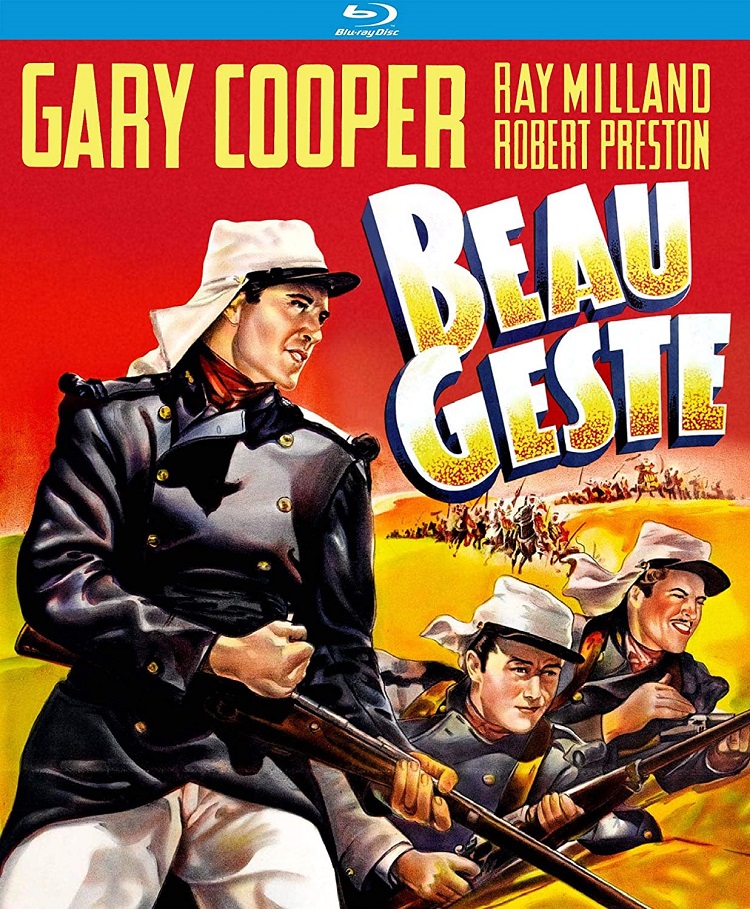
Directed by William Wellman, this second film adaptation of P.C. Wren’s 1924 adventure novel of the same name stars Gary Cooper, Ray Milland, and Robert Preston as the three Geste brothers, Michael aka “Beau”, John, and Digby. The story’s theme is revealed at the outset as the film opens with an Arabian proverb: “The love of a man for a woman waxes and wanes like the moon…but the love of brother for brother is steadfast as the stars and endures like the word of the prophet.”
News of a large Arab attack on Fort Zinderneuf leads a column of French Foreign Legionnaires under the command of Major de Beaujolais to advance across the Saharan desert. Upon their arrival, they are shot at, yet find the soldiers positioned about the outpost are dead. The bugler volunteers to enter, but doesn’t open the gates. The Major heads in but there’s no sign of the bugler. A note is found on a dead body, a confession about stealing the “Blue Water” sapphire from Brandon Abbas, setting up a mystery.
The film cuts to 15 years earlier in England at the Brandon Abbas estate, presenting background information about the three young brothers and their benefactors, then moves forward 15 years, when the family patriarch intends to sell the “Blue Water” because of the family’s financial situation. With everyone wanting one last look, the sapphire is brought to the dining room. But the lights go out and when they come back on, the jewel has disappeared with no one fessing up. Beau leaves a note for Digby announcing he has run off with the “Blue Water”. Then Digby leaves a similar note for John, saying both he and Beau are involved. John goes after them, and all three end up in the Foreign Legion.
The portrayal of the Legion is interesting because they aren’t a band of brothers. The Gestes talk of being jewel thieves, which interests fellow Legionnaire and thief Rasinoff (J. Carrol Naish), who tries to obtain it. Sergeant Markoff (Brian Donlevy in an Oscar-nominated performance for Best Supporting Actor) is a brutal leader. When he takes command of the fort, a mutiny is planned against him, but the two Geste brothers aren’t interested. When the mutiny is squashed, the brothers refuse to shoot unarmed prisoners, placing themselves in the middle of the factions. Adding to the chaos, Arabs attack fort, the attack mentioned at the beginning of the film, causing the Legionnaires to begrudgingly unite against a common foe. The big battle sequences attacking the fort are well staged.
The story comes full circle and we get to see what happened to the bugler once he entered the fort. The plot has cool twists as the who and why of the jewel was stolen is revealed, although it is puzzling why the character would risk his life over it.
The video has been given a 1080p/MPEG-4 AVC encoded transfer displayed at an aspect ratio of 1.37:1. Derived from a brand new 4K master, the image has more positives but occasional negatives. The blacks are inky but crush in a few scenes of low light like inside Brandon Abbas and during the day-for-night shots during the attack on the fort. Whites are bright, though can bloom as seen with the Major’s cape outside the fort. Fine texture detail is apparent, especially in structures like the fort and the Abbas staircase, but some scenes have soft spots. There’s a good amount of film grain. White specks appear and there’s a big vertical scratch down the middle of the frame before John kisses Isobel (Susan Hayward) goodbye.
The audio is available in DTS-HD Master 2.0 mono. Dialogue is clear. Alfred’s Newman’s score is robust and makes the most use of the dynamic range, but it slightly distorts when the music gets too loud, such as during the battle. Along with the effects, the elements are mixed well together.
The bonus feature is an informative audio commentary by William Wellman Jr. and historian Frank Thompson chatting together. There are also 11 trailers, including the main feature’s.
Beau Geste epitomizes the adventure film of a bygone era. Although there’s not a lot of depth to the characters, the trio of actors are charming together and keep viewers engaged no matter how many appear on screen. The Blu-ray from Kino Lorber Studio Classics presents a pleasing high-definition experience that would only be improved by a restoration.